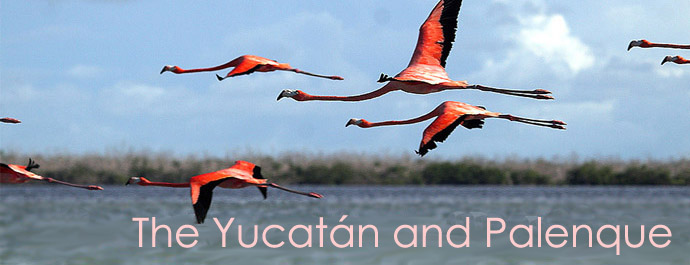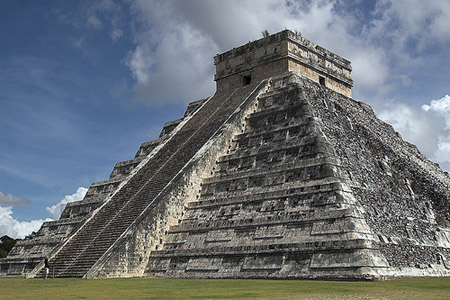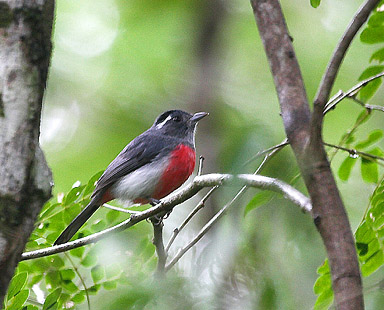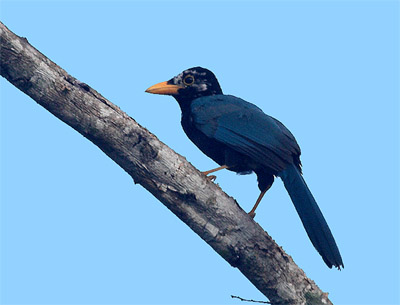
The
Yucatán
and Palenque:
Forthcoming Departures:
TBA 2008 (16 days)
$TBA from Cancún,
ending in Villahermosa
Single Supplement: $TBA
"Yucatán"--the word conjures images
of endless turquoise seas and ancient Mayan ruins hidden beneath dense
jungle. You'll experience both of these on our tour to the
Yucatán and
Palenque, as well as a unique regional cuisine and up to 16
regionally-endemic bird species. We'll visit a wide array of
habitats, from mangrove-lined salt flats and desert scrub to lush
canopy rain forest and tropical savannah. An archaeologists's
dream, we
visit an extensive list of spectacular
Mayan ruin sites: Chichén Itzá, Cobá, Tulum,
Calakmul,
Palenque, Bonampak, and Yaxchilán. Amongst them, they
offer chances to see heart-stopping birds, like Keel-billed Toucan,
Red-capped Manakin, Ornate Hawk-Eagle, Ocellated Turkey, and Scarlet
Macaw, as well as monkeys and even wild cats. This tour is timed
to coincide with the spring migration of North American migrant
songbirds, ensuring a magical experience.
Day 1: Arrive in
Cancún. Take advantage of the easy-going
Caribbean atmosphere and relax! Night in Cancún.
Day 2: We'll start birding this morning at a nice botanic gardens, just south of town. While searching for Rose-throated Tanagers and Yucatán Vireos, we should be entertained by some more widespread birds like Cinnamon Hummingbird and Rufous-browed Peppershrike. Continuing west, we'll stop at the breathtaking ruins of Chichén Itzá (chee-CHEN eet-SAH). Here we hope to see Turquoise-browed Motmot, Yucatán Jay, Orange Oriole, Canivet's Emerald, and Blue Bunting, all birds more typical of the Yucatán mainland. Night in Valladolíd (bye-ah-doh-LEED).
 Day 3: Río Lagartos.
Situated on the north coast of the Yucatán, Río Lagartos
is most famous as a location to view hundreds if not thousands of
American Flamingos. Habitats (and thus birdlife) are varied, from
salt flats and mangroves to thorn-forest and desert-like scrub.
The thorn forest supports three birds we won't see elsewhere,
White-lored Gnatcatcher, Yucatán Wren, and the gorgeous little
Mexican Sheartail. We'll also keep an eye out in this habitat for
Lesser Roadrunner and Yucatán (Black-throated) Bobwhite. A
short boat ride through the mangroves may
yield Boat-billed Heron, Bare-throated Tiger-Heron, Mangrove Cuckoo,
Mangrove Vireo, and even the spritely American Pygmy Kingfisher!
Night in Valladolíd.
Day 3: Río Lagartos.
Situated on the north coast of the Yucatán, Río Lagartos
is most famous as a location to view hundreds if not thousands of
American Flamingos. Habitats (and thus birdlife) are varied, from
salt flats and mangroves to thorn-forest and desert-like scrub.
The thorn forest supports three birds we won't see elsewhere,
White-lored Gnatcatcher, Yucatán Wren, and the gorgeous little
Mexican Sheartail. We'll also keep an eye out in this habitat for
Lesser Roadrunner and Yucatán (Black-throated) Bobwhite. A
short boat ride through the mangroves may
yield Boat-billed Heron, Bare-throated Tiger-Heron, Mangrove Cuckoo,
Mangrove Vireo, and even the spritely American Pygmy Kingfisher!
Night in Valladolíd.
Day 4: Cobá, Tulum, and Felipe
Carillo Puerto. After an early morning rise, we'll head south
toward lusher coastal forest. First, we'll stop at Cobá, a
ruins site famous for its adjacent lake, which supports a population of
Spotted Rail. With some luck, we'll catch a glimpse as one walks
through the reeds. Other targets here include Ridgway's
Rough-winged Swallow, Yucatán Woodpecker, and White-browed
Wren. Not far down the road, situated on a sprawling white sand
beach, is the ruins site of Tulum. We'll enjoy a leisurely lunch
at this site, taking in the spectacle of millenia-old ruins against a
backdrop of the crystal blue Caribbean. After lunch, we continue
south to Felipe Carillo Puerto. Just outside FCP, the birds get
really exciting. Black Hawk-Eagle, Yucatán Flycatcher,
Long-billed Gnatwren, Blue Ground-Dove, Collared Araçari, and
Red-capped Manakin are just some of the incredible birds that we may
encounter. At dusk, we'll go out to look for two endemic
goatsuckers, Yucatán Nightjar and Yucatán Poorwill.
Night in FCP.
 Day 5: FCP to
Xpujil. After morning birding and lunch at FCP, we'll drive down
to the Belize border, and then west, to the village of Xpujil (shpoo-HEEL), where we will spend
the night.
Day 5: FCP to
Xpujil. After morning birding and lunch at FCP, we'll drive down
to the Belize border, and then west, to the village of Xpujil (shpoo-HEEL), where we will spend
the night.
Day 6: Calakmul. An early
morning departure will allow us to be on the entrance road to Calakmul
by daybreak. Just north of the Guatemalan border, Calakmul (kah-lock-MOOL) is surrounded by the
Calakmul Biosphere Reserve, the northern end of an enormous tract of
pristine lowland tropical rain forest. The Selva Maya, or just
"the Petén", covers more than 5.5 million acres or Guatemala,
Mexico, and Belize. This is the largest untouched expanse of
tropical forest in the Americas outside the Amazon, and the fauna
reflects it. Jaguar, ocelot, jaguarundi, mountain lion, margay,
spider
monkey, and two species of howler monkey live here! The birds are
just as exciting. This is the only place in Mexico where one has
a decent chance of seeing Ocellated Turkey. Other exciting
possibilities include Black-headed Shrike-Tanager, Great Curassow,
Agami Heron, Royal Flycatcher, Northern Bentbill, and Red-legged
Honeycreeper. Night in Xpujil.
Day 7: Calakmul to Palenque.
After morning birding at Calakmul, we'll continue west to
Palenque. On the way, we'll stop to look for Jabiru, Sungrebe,
Pinnated Bittern, Snail Kite, Black-collared Hawk, as we bird the
marshes along the Río Usumacinta. Nearby savannahs should
yield Fork-tailed Flycatcher, Grassland Yellow-Finch, Lesser
Yellow-headed Vulture, and Double-striped Thick-knee. Night at
Palenque (pah-LEHN-kay).
Day 8: Palenque. The first few
minutes of daylight here will quickly assure you that Palenque's
reputations as both a phenomenal archaeological and an exquisite
birding site are well-earned. As we traverse the ancient temples,
birds vary from the ridiculously colorful (Keel-billed Toucan, Green
Honeycreeper, Lovely Cotinga, and Crimson-collared Tanager) to the
subdued and enigmatic (Great Tinamou, Mexican Antthrush, Rufous Piha,
and Scaled Antpitta). We will have three days to bird this
incredible area, giving us good odds at seeing a large percentage of
the resident birds. Night at Palenque.
Day 9: Palenque. We will bird
the Palenque area today, before heading southeast for the next two
days. Possibilities include Gray-throated Chat, Ornate
Hawk-Eagle, Spotted
Wood-Quail, Black-and-white Owl, White-necked Jacobin, Stripe-tailed
Hummingbird, Slaty-tailed Trogon, Tody Motmot, Rufous-tailed Jacamar,
Emerald Toucanet, White-collared Manakin, and Passerini's
Tanager. With some luck, we may find a Short-tailed Nighthawk
flying over our hotel at dusk. Night near Lacanjá (lah-kahn-HAH).
 Day 10:
Bonampak. This is another ruins site surrounded by rain forest,
but being further east, it offers birds that Palenque doesn't,
including Mealy Amazon, White-whiskered Puffbird, Speckled Mourner,
Scaly-breasted Hummingbird, Thrush-like Schiffornis, and Purple-crowned
Fairy. Like Calakmul, this is an incredibly remote area, so
though unlikely, visitors should always be on the lookout for
Orange-breasted Falcon and Harpy and Crested Eagles. Hummingbird
diversity can be impressive: Long-billed Hermit, Wedge-tailed
Sabrewing, Violet Sabrewing, and Black-crested Coquette are just a few
more of the possibilities. Night near Lacanjá.
Day 10:
Bonampak. This is another ruins site surrounded by rain forest,
but being further east, it offers birds that Palenque doesn't,
including Mealy Amazon, White-whiskered Puffbird, Speckled Mourner,
Scaly-breasted Hummingbird, Thrush-like Schiffornis, and Purple-crowned
Fairy. Like Calakmul, this is an incredibly remote area, so
though unlikely, visitors should always be on the lookout for
Orange-breasted Falcon and Harpy and Crested Eagles. Hummingbird
diversity can be impressive: Long-billed Hermit, Wedge-tailed
Sabrewing, Violet Sabrewing, and Black-crested Coquette are just a few
more of the possibilities. Night near Lacanjá.
Day 11: Yaxchilán.
Situated on the banks of the Río Usumacinta across from
Guatemala, Yaxchilán (yahsh-chee-LAHN)
offers more second-growth and riverside species than nearby
Bonampak.
This is the only reliable site in Mexico for Scarlet Macaw, one of our
main reasons for coming. To get to Yaxchilán, we'll take a
pleasant 45-minute boat ride down the river, which gives us a chance at
Collared Plover and a great vantage point for looking for soaring
birds. King Vulture, Double-toothed Kite, White Hawk, and Great
Black-Hawk. At the site itself, we'll keep an eye out in seeding
bamboo for Blue Seedeater, all the while hoping to hear the
distinctive, whistled song of Striped Cuckoo, which parasitizes the
resident Rufous-breasted Spinetails. Night at Palenque.
Day 12: Palenque. We will spend
all day birding the Palenque area today. Night in Palenque.
Day 13: Palenque to
Villahermosa. After another morning of birding at Palenque, we'll
head west to Villahermosa for a final, celebratory dinner. Night
in Villahermosa.
Day 14: Departure from Villahermosa.
CLIMATE: Warm
throughout, varying from dry
heat in the desert-like coastal scrub to muggy in the interior rain
forests. Though this is the
dry season, don’t be surprised if it’s wet
in the rain forest, so be sure to pack accordingly.
Cozumel
Extension
Forthcoming Departures:
TBA 2008 (3 days)
$TBA per person from Harlingen
Single Supplement: $TBA
Starting and ending in Cancún,
this extension starts three days before the main tour. Of the
four island endemics, Cozumel Wren, Cozumel
Vireo, and Cozumel Emerald should show themselves without too much
effort. A great deal of luck, however, will be needed to see
the rarest bird in all of Middle America, Cozumel Thrasher.
Thought extinct until the discovery of a single
bird in 2004, the devastating effects of Hurricane Wilma in October
2005 may have fianlly dealt the species its fatal blow. There are
many endemic subspecies on Cozumel as well: Western Spindalis,
Bananaquit, Roadside Hawk, and Rufous-browed Peppershike all have
distinctive populations that should pique our interest. Though
present on the
mainland as well, Yucatán (Yellow-lored) Amazon, Black Catbird,
Yucatán Vireo, and Rose-throated Tanager are often easier to see
on the island.
Cozumel offers a unique mix of these mainland, Caribbean (like
Caribbean Elaenia and White-crowned Pigeon), and migrant birds (like
Black-throated Blue, Prairie, and Cape May Warblers). Afternoon
birding is optional: those wishing to enjoy the beach or go
snorkeling are encouraged to do so. Nights on Isla Cozumel.
For more
information, contact Michael Retter at mlretter AT yahoo.com